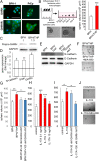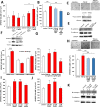Antagonists of growth hormone-releasing hormone inhibit proliferation induced by inflammation in prostatic epithelial cells
- PMID: 28123062
- PMCID: PMC5307470
- DOI: 10.1073/pnas.1620884114
Antagonists of growth hormone-releasing hormone inhibit proliferation induced by inflammation in prostatic epithelial cells
Abstract
The etiology of benign prostatic hyperplasia (BPH) is multifactorial, and chronic inflammation plays a pivotal role in its pathogenesis. Growth hormone-releasing hormone (GHRH) is a hypothalamic neuropeptide that has been shown to act as paracrine/autocrine factor in various malignancies including prostate cancer. GHRH and its receptors are expressed in experimental models of BPH, in which antagonists of GHRH suppressed the levels of proinflammatory cytokines and altered the expression of genes related to epithelial-to-mesenchymal transition (EMT). We investigated the effects of GHRH antagonist on prostatic enlargement induced by inflammation. Autoimmune prostatitis in Balb/C mice was induced by a homogenate of reproductive tissues of male rats. During the 8-wk induction of chronic prostatitis, we detected a progressive increase in prostatic volume reaching 92% at week 8 compared with control (P < 0.001). Daily treatment for 1 mo with GHRH antagonist MIA-690 caused a 30% reduction in prostate volume (P < 0.05). Conditioned medium derived from macrophages increased the average volume of spheres by 82.7% (P < 0.001) and elevated the expression of mRNA for N-cadherin, Snail, and GHRH GHRH antagonist reduced the average volume of spheres stimulated by inflammation by 75.5% (P < 0.05), and TGF-β2 by 91.8% (P < 0.01). The proliferation of primary epithelial cells stimulated by IL-17A or TGF-β2 was also inhibited by 124.1% and 69.9%, respectively. GHRH stimulated the growth of BPH-1 and primary prostate spheres. This study provides evidence that GHRH plays important roles in prostatic inflammation and EMT and suggests the merit of further investigation to elucidate the effects of GHRH antagonists in prostatitis and BPH.
Keywords: chronic prostatic inflammation; experimental autoimmune prostatitis; neuropeptide; prostatic hyperplasia; targeted therapy.
Conflict of interest statement
The authors declare no conflict of interest.
Figures



Comment in
-
Re: Antagonists of Growth Hormone-Releasing Hormone Inhibit Proliferation Induced by Inflammation in Prostatic Epithelial Cells.J Urol. 2017 Oct;198(4):747-748. doi: 10.1016/j.juro.2017.07.016. Epub 2017 Jul 14. J Urol. 2017. PMID: 28905791 No abstract available.
-
Re: Antagonists of Growth Hormone-Releasing Hormone Inhibit Proliferation Induced by Inflammation in Prostatic Epithelial Cells.J Urol. 2018 Nov;200(5):925. doi: 10.1016/j.juro.2018.08.024. Epub 2018 Aug 16. J Urol. 2018. PMID: 30360305 No abstract available.
Similar articles
-
Growth hormone-releasing hormone antagonists reduce prostatic enlargement and inflammation in carrageenan-induced chronic prostatitis.Prostate. 2018 Sep;78(13):970-980. doi: 10.1002/pros.23655. Epub 2018 May 21. Prostate. 2018. PMID: 29786867
-
Antagonists of growth hormone-releasing hormone (GHRH) reduce prostate size in experimental benign prostatic hyperplasia.Proc Natl Acad Sci U S A. 2011 Mar 1;108(9):3755-60. doi: 10.1073/pnas.1018086108. Epub 2011 Feb 14. Proc Natl Acad Sci U S A. 2011. PMID: 21321192 Free PMC article.
-
Antagonists of growth hormone-releasing hormone inhibit the proliferation of human benign prostatic hyperplasia cells.Prostate. 2010 Jul 1;70(10):1087-93. doi: 10.1002/pros.21142. Prostate. 2010. PMID: 20232355
-
Chronic inflammation in the pathogenesis of benign prostatic hyperplasia.Int J Androl. 2010 Jun 1;33(3):475-88. doi: 10.1111/j.1365-2605.2009.00972.x. Epub 2009 Jun 8. Int J Androl. 2010. PMID: 19508330 Review.
-
GHRH and the prostate.Rev Endocr Metab Disord. 2025 Jun;26(3):467-481. doi: 10.1007/s11154-024-09922-9. Epub 2024 Nov 7. Rev Endocr Metab Disord. 2025. PMID: 39505776 Review.
Cited by
-
Identification of Small-Molecule Antagonists Targeting the Growth Hormone Releasing Hormone Receptor (GHRHR).J Chem Inf Model. 2024 Sep 23;64(18):7056-7067. doi: 10.1021/acs.jcim.4c00577. Epub 2024 Aug 29. J Chem Inf Model. 2024. PMID: 39207455 Free PMC article.
-
GHRH and reproductive systems: Mechanisms, functions, and clinical implications.Rev Endocr Metab Disord. 2025 Jun;26(3):507-524. doi: 10.1007/s11154-024-09931-8. Epub 2024 Nov 29. Rev Endocr Metab Disord. 2025. PMID: 39612161 Review.
-
Natriuretic Peptides: The Case of Prostate Cancer.Molecules. 2017 Oct 10;22(10):1680. doi: 10.3390/molecules22101680. Molecules. 2017. PMID: 28994721 Free PMC article. Review.
-
A 50-year journey in the development of treatment for benign prostatic hyperplasia.NPJ Aging. 2025 May 23;11(1):41. doi: 10.1038/s41514-025-00231-2. NPJ Aging. 2025. PMID: 40410203 Free PMC article. Review.
-
Growth hormone-releasing hormone and its analogues in health and disease.Nat Rev Endocrinol. 2025 Mar;21(3):180-195. doi: 10.1038/s41574-024-01052-1. Epub 2024 Nov 13. Nat Rev Endocrinol. 2025. PMID: 39537825 Review.
References
-
- McNeal JE. Origin and evolution of benign prostatic enlargement. Invest Urol. 1978;15(4):340–345. - PubMed
-
- Levin RM, et al. Genetic and cellular characteristics of bladder outlet obstruction. Urol Clin North Am. 1995;22(2):263–283. - PubMed
-
- Levin RM, et al. Obstructive response of human bladder to BPH vs. rabbit bladder response to partial outlet obstruction: A direct comparison. Neurourol Urodyn. 2000;19(5):609–629. - PubMed
-
- Slater S, Dumas C, Bubley G. Dutasteride for the treatment of prostate-related conditions. Expert Opin Drug Saf. 2012;11(2):325–330. - PubMed
Publication types
MeSH terms
Substances
LinkOut - more resources
Full Text Sources
Other Literature Sources
Molecular Biology Databases
Research Materials

